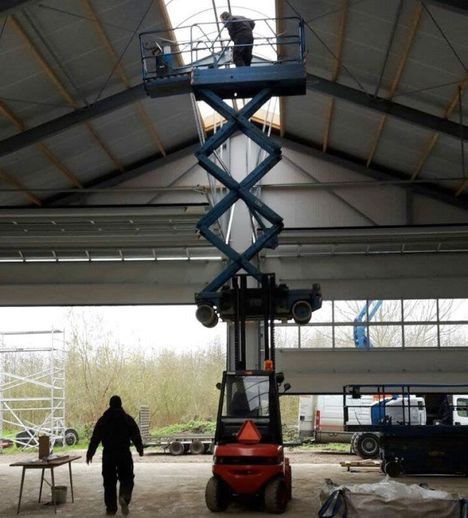
Is this really how these two pieces of equipment are supposed to be used’

One of the most basic’and critical’safe work practices is to use the right tools and equipment for the job. Improvising is rarely a good or safe idea.
This picture is a great example of how NOT to use forklifts and scissor lifts. It was taken by someone in the Netherlands and sent to Vertikal.net. (There’s another view of this dangerous situation below.)
Forklifts generally shouldn’t be used to lift or move people. And although they can properly be used to move or elevate materials and equipment, they certainly shouldn’t be used to lift a scissor lift in an extended position’and with a worker on it!
The forklift could easily topple over in this awkward position. The scissor lift could also fall off the forklift because it doesn’t appear to be secured to the forks in any way. And in either event, fall protection wouldn’t save the worker, although he doesn’t seem to be wearing a harness or fall arrest system.
Clearly, the scissor lift couldn’t lift the worker high enough to give him access to the roof. The appropriate solution to this dilemma was to choose another piece of equipment, such as a boom truck or scaffolding, that would give him safe access to the area where he needed to work.
5 Scissor Lift Safety Tips
To ensure the safety of your workers, provide them with the appropriate equipment and tools to safely do their jobs. And make sure that they know how to safely use the equipment that you do provide. For example, a FIOSA-MIOSA scissor lift safety fact sheet recommends these five tips for safe use of this equipment:
- Inspect the worksite. Because scissor lifts should be operated only on flat, level surfaces, inspect the worksite to ensure there are no uneven surfaces, drop offs or holes, bumps, floor obstructions or debris. Also, check for overhead hazards or other work/workers in the area where the lift will be operated.
- Inspect the equipment. Before workers use a scissor lift, they should visually check the platform floor, guardrails and toe boards, and ensure the tires and wheels are in good shape. They should also check that the controls are clearly marked for function and the hydraulics aren’t leaking.
- Test the equipment. Workers should test the ground controls, manual lowering control and platform controls, including emergency stops, to ensure the equipment is functioning properly. And they should check steering and drive functions.
- Wear proper PPE. Workers on a scissor lift should wear appropriate fall protection, such as a harness and fall arrest lanyard, as required by the OHS regulations or recommended by the manufacturer. They should also wear any other PPE required or recommended. For example, where overhead obstructions are present, they should wear hard hats.
- Get appropriate training. All workers who must operate a scissor lift should be trained so that they’re competent to do so. That is, they must receive adequate instruction and demonstrate competency in operating the equipment. (For more information on who qualifies as a ‘competent person,’ see ‘Compliance 101: What Makes a Worker a ‘Competent Person’ under OHS Laws’‘)
Download this model safe work procedure for powered aerial work platforms and adapt it for your workplace, OHS program and your jurisdiction’s OHS laws as they relate to such equipment.
